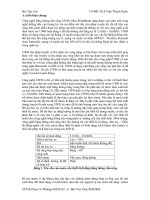Bài giảng Tiếng Anh về Risk Analysis (phân tích rủi ro)
Bạn đang xem bản rút gọn của tài liệu. Xem và tải ngay bản đầy đủ của tài liệu tại đây (784.06 KB, 77 trang )
SECTION RISK ANALYSIS
RISK ANALYSIS
Risk introduction
Risk analysis tools
Risk reducing solutions
RISK INTRODUCTION
What is risk ?
Why risk analysis ?
Types of risk
RISK
WHAT IS RISK?
Risk, in traditional terms, is viewed as a
‘negative’. Webster’s dictionary, for instance,
defines risk as “exposing to danger or hazard”.
The Chinese symbols for risk, reproduced below,
give a much better description of risk
The first symbol is the symbol for “danger”,
while the second is the symbol for
“opportunity”, making risk a mix of danger and
opportunity
WHAT IS RISK?
Risk is possibility of difference between actual
outcome and expected outcome as planned.
WHY RISK ANALYSIS ?
Future Certainty is Uncertainty
Project returns are spread over time
Most variables affecting NPV are subject to high
level of uncertainty
Information and data needed for more accurate
forecasts are costly to acquire
Need to reduce the likelihood to undertake a "bad"
project while not failing to accept a "good" project
WHY RISK ANALYSIS ?
Business is associated with uncertainty
To deal with uncertainty:
Assume things will be as planned and be ready
to adapt to possible change
Predict and limit uncertain elements
WHY RISK ANALYSIS ?
Decision making contexts
With Certainty
With Risk
With Uncertainty
Probability
Objective
Subjective
WHY RISK ANALYSIS ?
TYPES OF RISK
Systematic risk
Can diversify
Unsystematic risk
Can not diversify
Business risk
Financial risk
Strategic risk
TYPES OF RISK
BUSINESS RISK
Business risk relating product market of project,
includes:
Technological changes
Materials, Equipments
Product design
Substitute
Marketing
Market demand
Competitor operations
TYPES OF RISK
FINANCIAL RISK
Financial risk relating possible damages in financial
market
Changes in financial variables:
Interest rate
Exchange rate
Prices
Profitability
Solvency
Liquidity
TYPES OF RISK
STRATEGIC RISK
Strategic risk relating fundamental changes in the
economic and political environment
TYPES OF RISK
RISK ANALYSIS TOOLS
Sensitivity Analysis
Scenarios Analysis
Monte Carlo Risk Analysis
Software: Crystal-Ball, @Risk
Sensitivity Analysis is the first step to risk analysis
Test the sensitivity of a project's outcome (NPV) to
changes in one parameter value at a time
Basically "What if" analysis
Allows you to test which variables are important as a
source of risk
A variable is important depending on:
Its share of total benefits or costs
Likely range of values
SENSITIVITY ANALYSIS
LIMITATIONS OF SENSITIVITY ANALYSIS
Range and probability distribution of variables
Sensitivity analysis doesn't focus on the realistic range
of values
Sensitivity analysis doesn't represent the probabilities
for each range. Generally high probability of values
close to mean and a small probability of being at the
extremes.
Direction of effects
For most variables, the direction is obvious
A) Revenue increases NPV increases
B) Cost increases NPV decreases
C) Inflation Not so obvious
Continue next page
One-at-a-time testing is not realistic because of
correlation among variables
A) If Quantity (Q) sold increases, costs will increase
Profits = Q (P - UC)
B) If inflation rate changes, all prices change
C) If exchange rate changes, all tradable goods' prices
and foreign liabilities change.
One method of dealing with these combined or
correlated effects is scenario analysis
LIMITATIONS OF SENSITIVITY ANALYSIS
SCENARIO ANALYSIS
Scenario analysis recognizes that certain
variables are interrelated. Thus a small number
of variables can be altered in a consistent
manner at the same time.
What is the set of circumstances that are likely
to combine to produce different "cases" or
"scenarios"?
A. Worst case / Pessimistic case
B. Expected case / Best estimate case
C. Best case / Optimistic case
Note: Scenario analysis does not take into account the Probability of cases arising
SCENARIO ANALYSIS
Interpretation is easy when results are
robust:
A. Accept project if NPV > 0 even in the worst case
B. Reject project if NPV < 0 even in the best case
C. If NPV is sometimes positive, sometimes negative, then
results are not conclusive. Unfortunately, this would be
the most common case.
MONTE CARLO METHOD OF RISK ANALYSIS
A natural extension of sensitivity and scenario analysis
Simultaneously takes into account different probability
distributions and different ranges of possible values for
key project variables
Allows for correlation (co-variation) between variables
Generates a probability distribution of project
outcomes (Cash flows, NPV) instead of just a single
value estimate
The probability distribution of project outcomes may
assist decision-makers in making choices, but there
can be problems of interpretation and use.
STEPS IN BUILDING
A MONTE CARLO SIMULATION
1. Mathematical model: project evaluation spreadsheet
2. Identify variables which are sensitive and uncertain
3. Define uncertainty
Establish a range of options (minimum and maximum)
Allocate probability distribution, most common distributions being:
Normal distribution, Triangular distribution, Uniform distribution,
Step distribution
4. Identify and define correlated variables
Positive or negative correlation
Strength of correlation
5. Simulation model: does a series of analysis for various
combinations of parameter values
6. Analysis of results
Statistics
Distributions
SENSITIVITY ANALYSIS
$ Risk Variables
Price
Quantity
Revenue (V1 x V2)
Materials
Salaries
Expenses
Operating Cost (V3 + V4 +V5)
Fixed Cost
Total Costs (F2 + V6)
Profit/Loss (F1 - F3)
V1
V2
F1
V3
V4
V5
F2
F3
F4
V6
V1
V2
V3
V4
V5
FORECASTING THE OUTCOME OF
A FUTURE EVENT
From a Frequency to a Probability Distribution
Variable
Value
Frequency
1
3
5
1
x
x
x
x
x
x
x
x
x
x
Maximum
Minimum
Observations
Minimum Maximum
Variable Value
Probability
0.1
Minimum Maximum
Variable Value
0.3
0.5
0.1
Time
Now
The Single -Value Estimate
Variable Value
Probability
x
x
x
x
x
x
x
x
x
x
Observations
Variable Value
Time
Now
Mode
Average
Conservative
Estimate
The Deterministic
Probability Distribution
1.0
FORECASTING THE OUTCOME OF
A FUTURE EVENT









